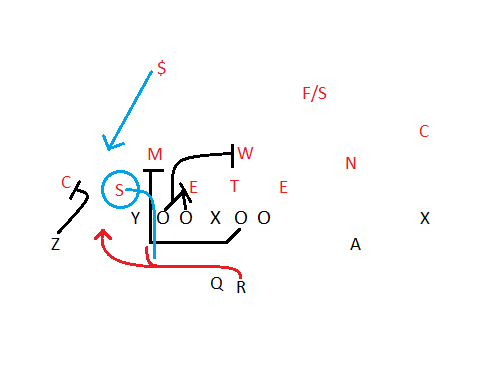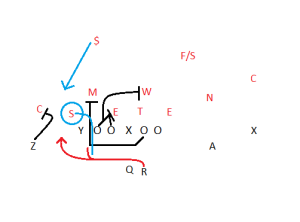Well, that’s more like it.
Stanford pounded UCF on Saturday evening. Now, to be fair, UCF had just come off a shocking upset loss to Florida International (which promptly lost by two scores to Indiana), and was returning just 10 starters from last year’s 9-4 squad. I wouldn’t look at this game and start predicting a nine-win season for the Cardinal. But any positive momentum is good momentum at a time like this.
The story of the game was probably the defense, which kept Stanford in the game at a time when Stanford couldn’t get any offense going whatsoever. Today, I want to focus on the game’s turning point, the forced fumble that led to a Stanford touchdown late in the second quarter. The turnover energized the Stanford team, and after the Cardinal scored on Kevin Hogan’s flea-flicker to Michael Rector, the team never looked back.
At this juncture in the game, the game’s tied at 0-0, and offense has been difficult to find. But UCF is driving, and for the second straight time, it has marched past the Stanford 40. It’s second down with eight yards to go at the Stanford 38. What will Stanford do?
UCF calls Power, a bread-and-butter run play for something around half of the teams in Division I, including Stanford. Essentially, in Power, the offensive linemen try to open up a hole in the defense by overloading one side of the line. The tight end (Y) (alternatively, a fullback or offensive tackle – Power is an example of how many different variants you can have on a single play) kicks out the end man on the line of scrimmage (S), the two offensive linemen to the inside double-team the first interior lineman, and an offensive guard from the other side of the line pulls to the outer side and leads his runner through the hole the other blockers create. (I apologize for the messy graphic. Most run plays are like that.)
Power is a good play if you can win your blocks at the line of scrimmage, but as longtime Stanford fans will realize, it’s easy for a defense to foul it up by forcing as much “trash” (in defensive lingo) through the hole as possible. That was what Stanford tried to do here. (As usual, Web viewers can look at the video here – fast forward to 0:16.)
The Cardinal are trying to “spill” UCF running back William Stanback (R) to the outside, where his lead blockers cannot help him. To do this, they ask Peter Kalambayi (blue circle) to make a difficult play: Kalambayi is lined up on the outside of UCF tight end Cal Bloom (Y) and doesn’t have inside leverage, but he needs to fight to Bloom’s inside and fill the hole.
If Kalambayi can get in the hole, it’s going to be tough for UCF to open it again, even if it has an offensive lineman about to run through it. If the defensive play-call works, the only thing Stanback can actually do is cut to the outside – he can’t, as they say, “run to daylight.” And outside cuts on inside runs typically favor the defense: The back loses most of his momentum by cutting, and more importantly, if the back is going to the outside, he’s not going forwards.
Kalambayi has a tough assignment, but he pulls it off with aplomb. The problem is that Brennan Scarlett (E, right next to Kalambayi) gets absolutely destroyed on the double-team. I want to be positive, but there’s no other way to put it. The only reason Stanford managed to execute the spill properly was because Jordan Perez (M) crashes on the hole immediately. With Kalambayi and Perez both in the hole, UCF still has a numerical advantage, but realistically it’s not going to be getting third-and-manageable on this play. Stanback cuts to the outside.
Once Stanback commits himself to the outside, Stanford pounces. Blake Martinez (W) bails out Scarlett by shedding his block like water, and delivers the first hit on Stanback. Dallas Lloyd ($) gets caught napping and takes an eternity to get to the ball, but when he sees Martinez make the tackle he knows he’s free to go for the ball. Scarlett, who never stopped running to the play, sees the ball come loose and jumps on it to snuff out a promising UCF drive.
That’s the play of the game for you. But I want to make a few concluding points. Firstly, props to Lloyd and Scarlett. Lloyd may have taken way too long to react against the run, but he was smart to realize that Martinez’s hit gave him an opportunity to go for the ball. Scarlett didn’t give up after getting pushed around at the point of attack, and even though he’s a fifth-year senior with as guaranteed a starting spot as you can get in Division I, he fought for the ball like a freshman fighting for playing time. I respect that.
Secondly, even if you lose on paper you can still make a difference, as Martinez’s effort beautifully shows. Thirdly, defense is a team effort. And although two players got recognition for that play, the box score almost never tells the whole story.
Contact Winston Shi at wshi94 ‘at’ stanford.edu.

